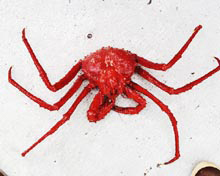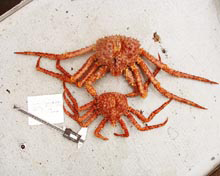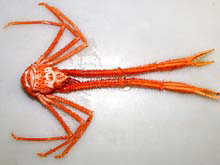
Red galatheid crabs, often called "pinch-bugs" (family Chirostylidae) are abundant on cobble and rocky slopes of Patton Seamount, and often perch on the branches of gorgonian corals. Click image for larger view.
Adaptations of Crabs to Life in the Deep Sea
Dr. Bradley G. Stevens
Chief Scientist on Leg 1
Fisheries Research Biologist
National Marine Fisheries Service
Kodiak Fishery Research Center
Most of what we know about crabs comes from studies on shallow water species, such as the red king crab (the kind we normally eat). But as you go deeper into the sea, the crabs you encounter become ever more strange. Most have evolved specific adaptations to cope with life in deep water. What are some of these, and what advantages do they offer?
First of all, king crabs are not typical crabs. They are closely related to hermit crabs, and have many similar characteristics. Their abdomens (or tail-section) are twisted to one side, they have large right-handed claws, and their legs fold backwards, instead of forwards. Thus they can walk straight forward, unlike a Dungeness crab that normally walks sideways. King crabs also have an unusual mode of development. Most crabs hatch from eggs as a swimming shrimp-like larva, that immediately begins to feed on small planktonic organisms. Red king crabs do this too, but before they become bottom-dwelling crabs, they go through a transitional stage that is not capable of eating. Red king crabs live in relatively shallow water (less than 50 m). Because of this they are exposed to seasonally changing conditions of temperature and day length. As a result, they all reproduce during a specific season in the spring. However, most seamounts in the Gulf of Alaska are too deep for red king crabs.
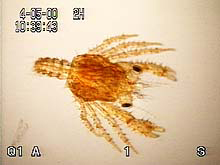
The glaucothoe is a transitional stage between the larval and juvenile stages of king crabs. It can swim like the larvae, but has claws, and prefers to find structurally complex habitat in which to settle. It lacks functional mouthparts or digestive apparatus so does not feed for 3 to 4 weeks, until molting to the juvenile stage. Click image for larger view.
Golden king crabs live much deeper, from 200-500 m, so they may not be exposed to strong seasonal signals. As a result, they may not reproduce simultaneously, or even in the same season. Research (by Tom Shirley) has demonstrated that the larvae of golden king crabs do not eat at all, but live off stored yolk, until they become bottom dwelling crabs many months later. In fact, no one has ever captured a larval golden king crab from the ocean. Eggs of golden king crabs are twice as large as those of the red king crab, and contain much more yolk. This is probably an adaptation allowing the larvae to survive at depths where there is much less plankton available as a food source. The scarlet king crab lives even deeper than the golden king crab, and has legs that are much thinner in respect to their length. This may be an adaptation to low oxygen levels, since the scarlet crab lives at 1000 m, near the oxygen minimum zone. Thinner legs require less oxygen, hence less energy. We don't know what the larvae look like, or how they develop, or when they hatch, or what or even if they eat.
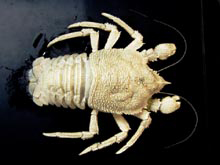
Munidopsis albatrossae, a blind "squat lobster" that lives at depths > 2500 m. Click image for larger view.
A relative of king crabs, called the squat lobsters, lives below 2000 m. They are ghostly white and have no eyes. They live in rocky habitats where they can probably find food using their sense of smell. Because there is no light at this depth, they have little use for eyes, like a blind cavefish.
The deepest crab in the Gulf of Alaska is the large-clawed spider crab. Its body is about 10 cm across, but the legs reach up to 50 cm in length. The claw segment of adult males is over a foot long. They look like a giant daddy-long legs spider on steroids. These crabs live down to at least 3400 m (over 11,000 feet), and yet they have eyes. What for? What purpose do the long legs serve? How do they reproduce? These are some of the questions we will attempt to answer on our dives in Alvin.
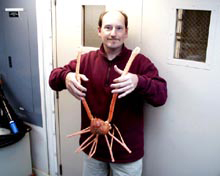
Dr. Bradley Stevens holds a male large-clawed spider crab, Macroregonia macrochiera, collected from a depth of 3300 m on Patton Seamount in the Gulf of Alaska. This is the deepest and most northern location they have been observed. Click image for larger view.
Most of the other crab species are restricted to specific depth zones by temperature requirements. The only way they can spread to other seamounts is by releasing swimming larvae that are carried across the sea by water currents. The large-clawed spider crab, though, may be able to descend all the way to the bottom of the ocean. In effect, it probably walks across the seafloor, from Hawaii to Alaska. Because there isn't much food down there, it may feed on foodfalls, i.e. dead animals that fall from surface waters, such as whales, sea lions, or large fish. Crabs can go for long periods without eating. When they find a food source, they can live off it for some time, until it is consumed, then go on their way searching for others. At foodfalls such as this, predator organisms and bacteria may give off phosphorescence (light produced by living organisms) that is detectable by the spider crabs eyes.
Their long legs may be an adaptation for traveling long distances. We have much to learn about deep-water crabs, or other species in the deep sea. They are fascinating and puzzling. They can tell us much about how animals cope with life in the deep sea, but they present new and challenging questions as well. We'll never be able to answer them all, but maybe, just maybe, our dives in Alvin will offer us a glimpse of understanding. We hope to use our newfound knowledge to understand and conserve these deep-water species for generations to come.
Sign up for the Ocean Explorer E-mail Update List.



























